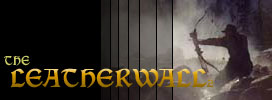| From: Bugle up
|
|
|
|
|
|
|
| Date: 14-Oct-21 |
|
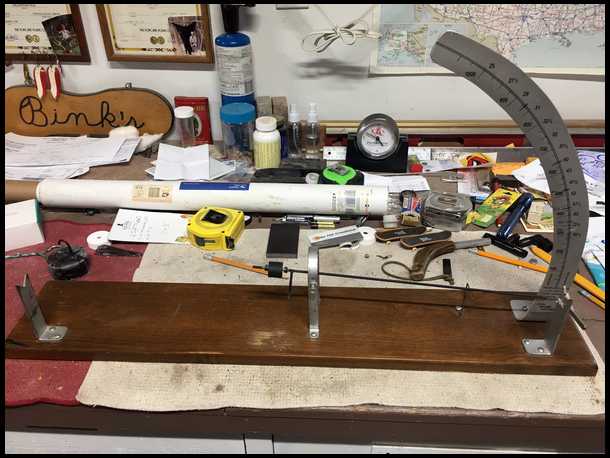
I need to calibrate a Don Adams spine tester and am pretty sure where to make adjustments, however probably need shaft(s) of absolute known spine weights to make said adjustments. Don't know if I have shafts I can completely rely on for this task. Any thoughts or suggestions?
|
|
| From: fdp
|
|
|
|
|
|
|
| Date: 14-Oct-21 |
|
Aluminum.
|
|
| From: DanaC
|
|
|
|
|
|
|
| Date: 14-Oct-21 |
|

Yup. Here's some aluminum shaft sizes and deflections in inches. Measured at 28".
|
|
| From: SB
|
|
|
|
|
|
|
| Date: 14-Oct-21 |
|
Whats there to calibrate? Put a shaft on it,zero the pointer,hang the weight on it and read the deflection!
|
|
| From: M60gunner
|
|
|
|
|
|
|
| Date: 14-Oct-21 |
|
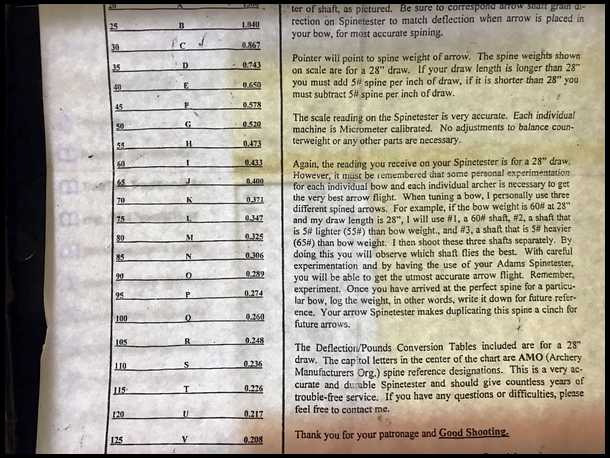
I took a photo of the directions from tester. Has a chart that might help? This is at least 20 years old.
|
|
| From: Bugle up
|
|
|
|
|
|
|
| Date: 14-Oct-21 |
|
SB, I don't know that that the spine tester is calibrated correctly, meaning if I put a shaft on it of 65# spine I don't know if the spine tester will read 60#, 65# or 70#. I need to make sure it is calibrated correctly. It has adjustments to make, but I need to know at what point it is calibrated correctly.
|
|
| From: Bugle up
|
|
|
|
|
|
|
| Date: 14-Oct-21 |
|
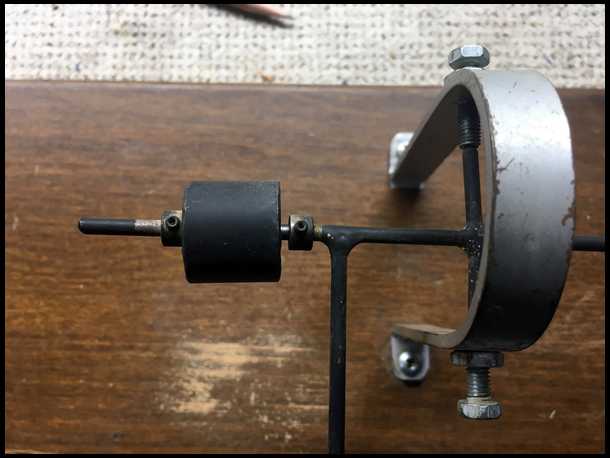
I can adjust this counterweight in order to calibrate the scale, however I need an arrow or shaft (maybe multiple shafts of known weights) to calibrate correctly.
|
|
| From: Bugle up
|
|
|
|
|
|
|
| Date: 14-Oct-21 |
|
DanaC, if I calibrate against an aluminum shaft, I can then assume it is zeroed in for wood? I thought I had read in the past that these spine testers are not designed to give spine weights for aluminum?
|
|
| From: M60gunner
|
|
|
|
|
|
|
| Date: 14-Oct-21 |
|
With this type of tester you may not get the accuracy you want. The only “adjustment “ I know is the one that zeros the pointer with a shaft loaded before adding the weight. Maybe if you ask someone like Surewood shafts they could help you.
|
|
| From: aromakr
|

|
|
|
|
|
|
| Date: 14-Oct-21 |
|
There is nothing on that tester to calibrate ! I would take the counter weight off, its not needed, I have never seen an Adams tester with a counter weight. it just lays lightly on the shaft. Then zero the pointer and add the weight, read the deflection. I would double check the 2# weight for accuracy. That's all that is needed.
Bob
|
|
| From: Phil Magistro
|
|
|
|
|
|
|
| Date: 14-Oct-21 |
|
Spine should be spine regardless of the material. Looking at your photos I see that your counterbalance is in a different position than mine. Mine is all the way to the end.
The issue I have is that the Adams tester measures spine at 26”. Most published spines are at 28”. At 28” a 2016 has a deflection of .531. On my tester, at 26”, the deflection is .450.
If anyone has a deflection chart for aluminums at 26” it would be most helpful..
|
|
| From: fdp
|
|
|
|
|
|
|
| Date: 14-Oct-21 |
|
Any spine tester can be used to establish spine on any shaft material.
All spine is, is the deflection of how far the shaft bends.
In the case of wood shafts that deflection is determined by using ax2lb. weight over a 26" span.
The industry measures Aluminum using a 1.94lb weight over a 28" span. But it is simple to convert one to the other.
|
|
| From: babysaph
|

|
|
|
|
|
|
| Date: 14-Oct-21 |
|
Now I am confused. I use it for my wood shafts. So If I measure a wood shaft is it correct or not?
|
|
| From: SB
|
|
|
|
|
|
|
| Date: 14-Oct-21 |
|
Deflection is deflection! I spine everything at 26". Dosn't matter the material. All that weight is is a counterweight. Without it the pointer goes nuts. The don Adams tester should have come with a deflction chart. I have one I used to build my homeade version.
|
|
| From: SB
|
|
|
|
|
|
|
| Date: 14-Oct-21 |
|
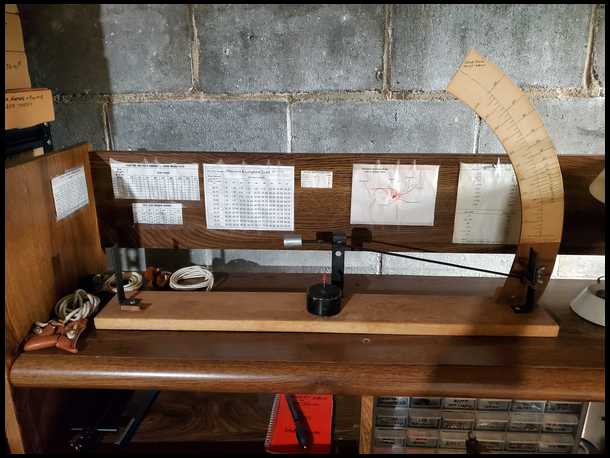
|
|
| From: SB
|
|
|
|
|
|
|
| Date: 14-Oct-21 |
|
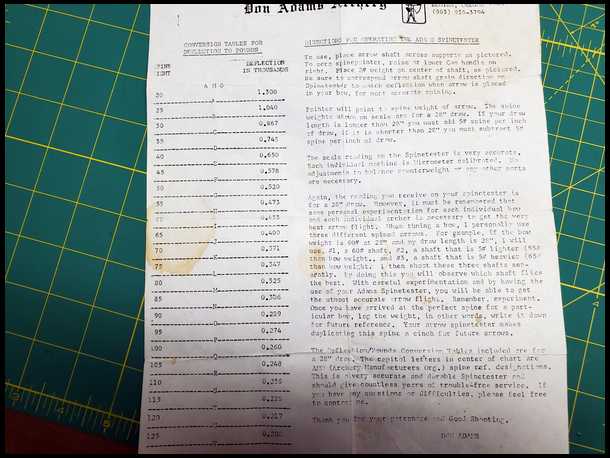
|
|
| From: fdp
|
|
|
|
|
|
|
| Date: 14-Oct-21 |
|
Phil just multiply the 28" spine by .85, that will give you the 26" spine.
|
|
| From: SB
|
|
|
|
|
|
|
| Date: 14-Oct-21 |
|
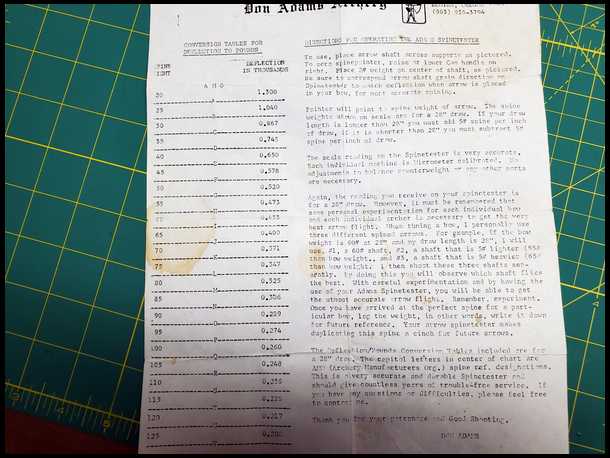
You could hang a shsft on 2 nails at your specified distance apart,put your weight on it and measure the deflection with a dial indicator or vernier...then put it on your spine tester and see if the deflection is the same ...or adjust for it. I'm not seeing how that counterbalance on the pointer is going to adjust anything,other than the speed the pointer falls when you remove a shaft.
|
|
| From: babysaph
|

|
|
|
|
|
|
| Date: 14-Oct-21 |
|
I didn't get a chart and if I did it was 35 years ago. Have no clue where it is. I am back to just shooting the shafts and see which one flies best. I left the math back in college.
|
|
| From: fdp
|
|
|
|
|
|
|
| Date: 14-Oct-21 |
|
Well JR. unless you buy a bunch of shafts and sort them by shooting and grouping, you are doing math somewhere because you gotta' know where to start.
|
|
| From: SB
|
|
|
|
|
|
|
| Date: 14-Oct-21 |
|
I can try a better pic of my chart if that will help. It dosn't blow up well on my phone...maybe on a computer?
|
|
| From: fdp
|
|
|
|
|
|
|
| Date: 14-Oct-21 |
|
If someone is using a computer they should be able to save the image of the chart to their desktop, then enlarge it.
The question will be how clear the image is when enlarged.
|
|
| From: Bugle up
|
|
|
|
|
|
|
| Date: 14-Oct-21 |
|
You guys are helping me on my quest. As always, much appreciated. I'm heading back out into the shop to mess with it some more and see what I can figure out. I have an old one, given to me by a friend, and it spines arrows much different than this one. I trust this one more, but I'm trying to figure out how I can KNOW which scale is correct?
|
|
| From: Kelly
|
|
|
|
|
|
|
| Date: 14-Oct-21 |
|
If you go to my old website www.arrowskp.com then to the spine chart page you will find the poundage spine of a lot of different aluminum sizes all done on my Scheib spine tester at 26” centers. To find the deflection in thousands divide 26 by pounds equals deflection and vice versa if you know the deflection and want pounds spine.
The only calibration needed is to see that a specific deflection equals the correct poundage reading. 50# should equal .520 and likewise .260 should equal 100 # spine. Some scales are off on the upper end like around 70# and up.
|
|
| From: Corax_latrans
|
|
|
|
|
|
|
| Date: 15-Oct-21 |
|
I have one just like that.
I satisfied my curiosity by checking the spine on some Cedars which I had ordered (as a test kit) and which were individually marked to the pound, and every one of them measured exactly as marked by Wapiti. I figure it’s way more accurate than I will ever be, so good enough is good enough.
|
|
| From: Phil Magistro
|
|
|
|
|
|
|
| Date: 15-Oct-21 |
|
Thanks Frank and everyone. SB, the photos don't enlarge well enough to read on my computer.
I tend to agree with SB and don't understand the role of the counterbalance in measuring deflection.
|
|
| From: SB
|
|
|
|
|
|
|
| Date: 15-Oct-21 |
|
Well 50 lbs. Is .520 deflection, if a known 50# shaft reads .520 the rest will follow suit. That counter weight on the pointer is only for dampening the rate of fall of the pointer when you take the shaft off the spine tester. There is no calibration involved,other than zeroing the pointer when you put a shaft on it before you hang the weight.
|
|
| From: fdp
|
|
|
|
|
|
|
| Date: 15-Oct-21 |
|
For those who asked here is a link to a spine chart that converts aluminum to wood equivalent. I've posted it before but I couldn't find the thread.
http://oakcreekarchery.com/wp-content/uploads/2010/06/Al_Carb- Spine.pdf
|
|
| From: GLF
|
|
|
|
|
|
|
| Date: 15-Oct-21 |
|
Aluminum was made to use 26 inch centers. Thats why eastons charts and most others are off and will give you arrows too stiff.. Find an old spine chart and go by deflection, not spine weight and your spine tester is calibrated by moving the pointer to 0 for each shaft.
|
|
| From: tecum-tha
|

|
|

|
|
|
|
| Date: 15-Oct-21 |
|
You don't calibrate the tester with the counterweight. The counterweight is there to counterbalance the weight of the dial. You want that to be essentially in balance. The formula to calculate between wood spine and aluminum spine is: Wood equivalent spine = (26/deflection in inches of aluminum shaft)x1.2115
Example: 2016 tribute XX75 aluminum shaft. Deflection from easton table at 28" given as: 0.531"
Therefore: Wood equivalent spine = (26"/0.531")x1.2115 = 59.32
It is better checked with weaker shafts, because the wood spine correlation scale is most accurate between 30 and 50# wood spine, ok until 60#, then accuracy declines. You can see that in smaller distance between the spine scales. This is overcome by getting a heavier weight (3# works best) and measure stiffer shafts with this. You just multiply the reading on your spine tester with 1.5 when you use the 3# weight.
But there is no way to really calibrate a scale on these testers. The dial is a magnifier of the relationship between the measuring point on the shaft, the axis and the length of the dial to the scale. That's why they are easy to build and with CAD you can create your own scale.
|
|
| From: Bugle up
|
|
|
|
|
|
|
| Date: 15-Oct-21 |
|
I worked with the two spine testers last night and figured out the orientation of the scale (as mounted on the board) was different for each. They were both setup for measuring 26" and the deflection bar was at 13" on both, but the scales were attached to the boards in different relation to the pointer. I remounted the scales so they were in same relation to the pointers and they then both gave identical readings for spine. Now, rather than assume they are giving correct readings I will go to the advice given above and do some tests with aluminum. Thanks for all the help, you folks are a treasure trove of information!
|
|
| From: Steve P
|
|
|
|
|
|
|
| Date: 15-Oct-21 |
|
Kelly, your chart on the website was the first thought that ran through my mind. If I looked around I could probably find the copy I printed. If I recall correctly, there were spines for XX75 and the old 24srt shafting. Same size shafts spines a little different as they were made from different "grades" of aluminum?
Steve
|
|
| From: Kelly
|
|
|
|
|
|
|
| Date: 17-Oct-21 |
|
Yes, Steve that is correct. My website should still be working? www.arrowskp.com
|
|
| From: Deno
|
|
|
|
|
|
|
| Date: 07-Nov-21 |
|
Still working Kelly. My go to for arrow spine info
Deno
|
|
| From: Orion
|

|
|

|
|
|
|
| Date: 05-Jan-22 |
|
If you use an arrow with a given spine to calibrate your tester, you never can be sure if the arrow you actually meets specs. SB's suggestion of hanging a weighrt on a shaft to measure deflection and then placing that shaft on the spine tester to see if it gets the same results is one way to go.
The other is to get a plunger micrometer and affix it to your tester so the plunger rests on the shaft's mid-point. Then, bend the shaft to different deflections and see if the needle points to the correct poundage for the given deflection. Hope that makes sense.
However, I agree with others who said the tester doesn't need to be calibrated. You might check to make sure you have a 2# weight and that that the support posts are 26 inches apart and that the pointer arm isn't bent, but given those are on spec, the scale will yield the correct reading.
Regardless, it will yield consistent results, which is all you need to put together spine groups for personal use.
|
|
| From: Bowone1
|
|
|
|
|
|
|
| Date: 05-Jan-22 |
|
I have one of those and the instructions that came with it . Here's a quote from them (The scale reading on the spine tester is very accurate. Each individual machine is micrometer calibrated. No adjustments to balance counterweight or any other parts are necessary.)
|
|
| From: Bugle up
|
|
|
|
|
|
|
| Date: 16-Jan-22 |
|
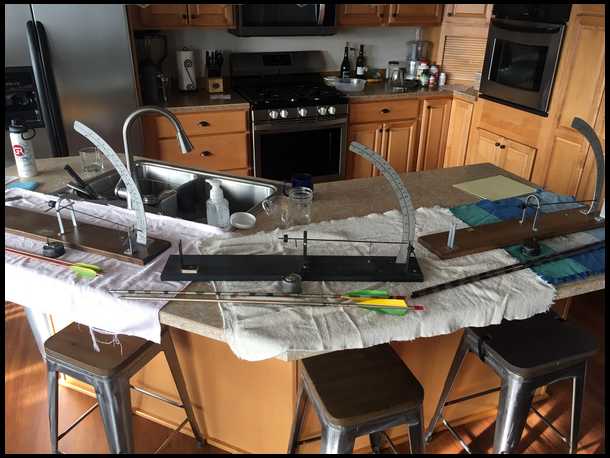
So I concluded my Don Adams spine tester validation quest this weekend. I had my two spine testers and I borrowed one from a friend. Oddly, all three spine testers came with 1.94# weights instead of the 2# weights which are supposed to be the standard for wood arrows. As was pointed out above, apparently 1.94# has been used for measuring the spine of aluminum (and maybe over a 28" span instead of 26"?). Long story short, I added lead to my two weights bringing them up to 2#. I tested with aluminum (I was provided a spine chart for aluminum) and in the process found some wood shafts I had forgotten about which came from 3 Rivers Archery and had their spine marked on the package. I found that the 2# weights gave correct measurements, while the 1.94# weight was not accurate. So, moral of the story, if you have a Don Adams spine tester, check the weight. If you do not have easy access to a precise scale, run by the Post Office and they will weigh it for you. I was shocked that out of the three spine testers in my possession, all three had the 1.94# weights. Mike
|
|
| From: JusPassin
|
|
|
|
|
|
|
| Date: 17-Jan-22 |
|
And what distance apart are the supports on those testors you have, 26" or 28"?
|
|
| From: Orion
|

|
|

|
|
|
|
| Date: 17-Jan-22 |
|
Bugle: Thatis interesting, indeed. And surprising. Thanks for sharing that info.
|
|
| From: arras r fun
|
|
|
|
|
|
|
| Date: 17-Jan-22 |
|
If you go to my website you will find several papers that go through the math of converting shaft spine between the two systems and you could derive the equivalent for any weight or span you might have. There are also tables that show the spine of aluminum and carbon that one would get using a wood spine tester with 2# and 26 inches.
www.oakcreekarchery.com
|
|
| From: Bugle up
|
|
|
|
|
|
|
| Date: 17-Jan-22 |
|
The three spine testers pictured above all have a 26" span. It's the weights which were interestingly all 1.94# instead of 2#.
Thanks arras, I'll look those charts up.
|
|
| From: raghorn
|
|
|
|
|
|
|
| Date: 17-Jan-22 |
|
My Tessiers(not testors) has a lead weight that does weigh 2.00 lb. The weight has holes drilled into the bottom that were for adjusting the weight. The right side arrow support arm can be rotated giving a 28"length or 26" length.
|
|
| From: GLF
|
|
|
|
|
|
|
| Date: 17-Jan-22 |
|
Aluminum arrows were designed to be spined at 26" centers. I still have an old spine chart from the 80's in storage. So if needed I break out my old spine charts but still use 26" centers and 2 lbs. No conversions needed. I don't mess with carbon so I don't care how its measured.
As for Adams spine testers theres nothing to adjust except bringing it to zero on every shaft you put on it. Oh and making sure its 26"centers and 2 lb weight. Hard to imagine now days something thats so simple.
|
|
| From: Bugle up
|
|
|
|
|
|
|
| Date: 17-Jan-22 |
|
raghorn, pretty interesting.
I just checked out, arras r fun's, webpage...pretty darn cool arrow testers! You can see what happens when you get an engineer involved who incorporates electronics. Plus it is handy having his chart and formulas for aluminum.
I am now confident in my Adams spine testers for the little bit of spine testing I do. However I had to figure a few things out, and the whole history thing about aluminum and 28" and 1.94# weights helped.
|
|
| From: GLF
|
|
|
|
|
|
|
| Date: 17-Jan-22 |
|
I think he's the one who designed the tester that Is used At Trueshaft Archery where I buy my spruce. Pretty cool for production.
|
|
| From: JusPassin
|
|
|
|
|
|
|
| Date: 17-Jan-22 |
|
Definitely a production flaw, should have been 2 pound weights.
|
|
| From: GLF
|
|
|
|
|
|
|
| Date: 17-Jan-22 |
|
Yep Someone figure a weight change would update it. Having a new way to measure spine sounds like some org trying to be more relevant.
|
|
| From: babysaph
|

|
|
|
|
|
|
| Date: 17-Jan-22 |
|
I have an Adams as well. I just find what arrows shoot off my bows and spine em then compare all the others to that. It is possible that Mr. Adams was weighing his on scales that were off.
|
|
| From: arras r fun
|
|
|
|
|
|
|
| Date: 19-Jan-22 |
|
Yes, I designed the spine tester that Trueshaft Archery uses. Wapiti Archery also uses one. The tester will weigh, spine and print the results on the shaft in under 10 seconds. No human error in zeroing and very repeatable.
After I built my first spine tester I started thinking about the electronic spine tester and I was inspired to make it happen after several conversations with Dan about his desire for a better mouse trap.
|
|
| From: JusPassin
|
|
|
|
|
|
|
| Date: 19-Jan-22 |
|
How would such a tester orient the grain?
|
|
| From: GLF
|
|
|
|
|
|
|
| Date: 19-Jan-22 |
|
Very good question. I have Wapitis as well and they all seem good so far.
|
|
| From: Bob Rowlands
|
|
|
|
|
|
|
| Date: 19-Jan-22 |
|
The tester weight is placed parallel with the grain on a wood arrow. That means arrow grain is oriented vertically. That yields the strongest spine. I also orient the groove on the arrow nock perpendicular to the grain, because it is less likely to split. Actually that's the big reason I check spine with grain vertical.
|
|
| From: arras r fun
|
|
|
|
|
|
|
| Date: 19-Jan-22 |
|
The operator must orient the grain when placing it on the tester. Dan and I have discussed how to do an automatic feed and that is one of the sticking points, grain orientation.
There are several ways it could be done but they all require $$$ for the right kind of sensors.
|
|
| From: Bob Rowlands
|
|
|
|
|
|
|
| Date: 19-Jan-22 |
|
Totally off topic. I use an ACE 101 spin spine tester that I bought in 2004. Load shaft and spin check for straightness. Adjust until true. Adjust the shaft so the weight 'just' touches the shaft. I usually do a double check for average and then mark shaft for spine immediately in front of nock, parallel with grain. Easy fun fast and accurate. Ideal for me.
|
|
| From: JusPassin
|
|
|
|
|
|
|
| Date: 19-Jan-22 |
|
Yes, I have an Ace also, one of the finest testers you can own.
|
|
If you have already registered, please sign in now
For new registrations Click Here
|
|
|
|

